Dark spots on the blossom end of tomatoes, or even squash, peppers, or melons, may be a sign of blossom-end rot.
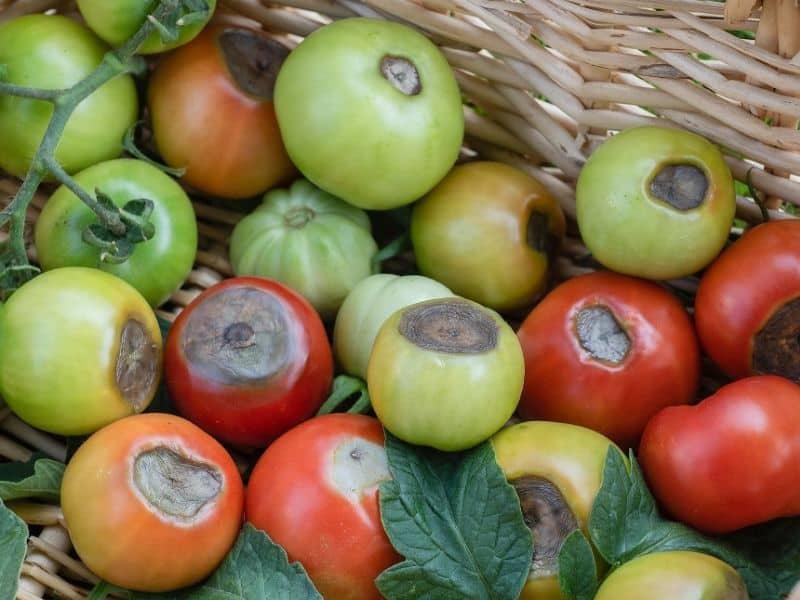
What Is Blossom End Rot
It is a physiological disorder that causes tissue in the blossom end of the fruit to break down and rot.
Though not a disease, blossom-end rot can be very damaging. It impacts both quality and yield of affected produce, resulting in losses of 50 percent or more in some cases. The good news is that if you notice blossom-end rot on your plants, there are measures you can take.
What does blossom-end rot look like?
Blossom-end rot typically affects the bottom, or blossom end, of fruits. It first appears as a small water-soaked spot resembling a bruise, which grows and darkens to dark brown or black and becomes leathery and sunken.
The lesion will sometimes cover the entire bottom half of the fruit, and regardless of its size, it can provide an entry point for pathogens. Occasionally, the fruit may appear sound until it is cut open to reveal a shrunken, discolored interior.
Blossom end rot often affects the first fruits produced by the plant while they are still green or ripening.
What causes blossom end rot
Tomatoes, squash, peppers, and melons require calcium to produce cell walls, so when the growing fruits lack this essential nutrient, their tissues begin to break down, forming the lesions characteristic of blossom-end rot.
Although this disorder may point to insufficient levels of calcium in the soil, it often results from difficulty transporting calcium through the plant. In other words, there may be plenty of calcium in the soil, but it isn’t getting to the fruits. This latter, more common problem can stem from:
- drought stress
- root damage
- waterlogged or cold soil
- wide fluctuations in soil moisture
- excess ammonium, potassium, and magnesium cations in the soil
- improper soil pH
- excessive nitrogen fertilization
How to prevent blossom-end rot
The first step to preventing blossom-end rot is to choose resistant varieties when shopping for seeds or transplants (see below for tomato suggestions). However, if your favorite variety isn’t tolerant of calcium deficiencies or you already have plants in the ground, there are several other precautions to take as well. And it’s a good idea to practice these even if you do plant resistant cultivars.
Always water plants regularly and evenly, as one of the main causes of calcium deficiency is inconsistent watering. To prevent waterlogged soil from excessive rainfall, ensure good drainage when preparing beds for planting. And be sure to apply a thick mulch around plants to guard against dry spells.
Avoid cultivating near or otherwise disturbing the roots of plants, as damaging them can prevent water, calcium, and other nutrients from being properly absorbed. Stakes or trellises should be carefully installed when the plants are still young and somewhat adaptable or even when they are planted.
Periodically check soil pH and nutrient levels and amend the soil as necessary – but be careful not to over-fertilize, as excessive nitrogen, magnesium, and/or potassium can increase susceptibility to or worsen blossom-end rot.
When adding nitrogen, use nitrate rather than ammonium, which can inhibit calcium absorption. If the soil tests show a deficiency in calcium and too much acid, lime is a great solution to both problems. But if the soil just lacks calcium, use crushed eggshells for a great low-cost option.
How to cure blossom-end rot
If your plants are already showing signs of blossom-end rot, many of the prevention strategies above can be enacted to help ensure the rest of your crop doesn’t rot on the vine. But first, remove any already affected fruits and eat them (after cutting out the bad spots). If they’re especially gross, throw them on the compost pile.
What Plants Are Affected By Blossom End Rot
Many people associate blossom-end rot with tomatoes, but it can affect squash, peppers, and melons as well.
Blossom-end rot in tomatoes
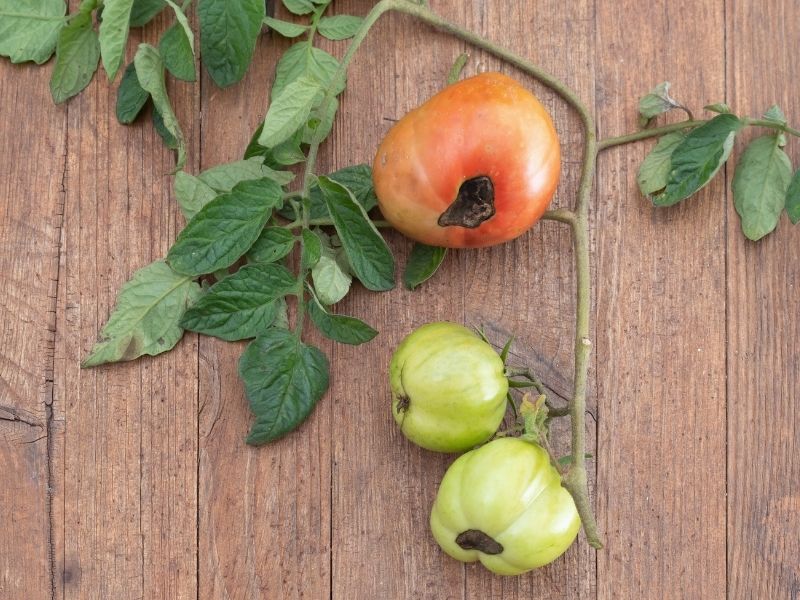
Tomatoes are often more sensitive to certain conditions than other vegetables, so a mild calcium deficiency may affect tomatoes before squash, peppers, or melons in your garden.
Blossom-end rot in zucchini and squash
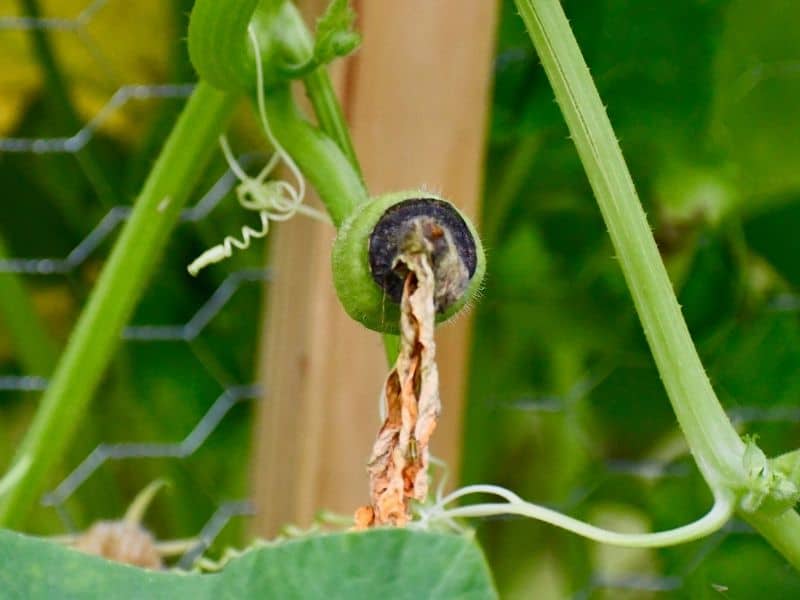
In zucchini and other squash with blossom-end rot, the ends become brown and soft, and the fruit may fail to develop properly.
Blossom-end rot in peppers
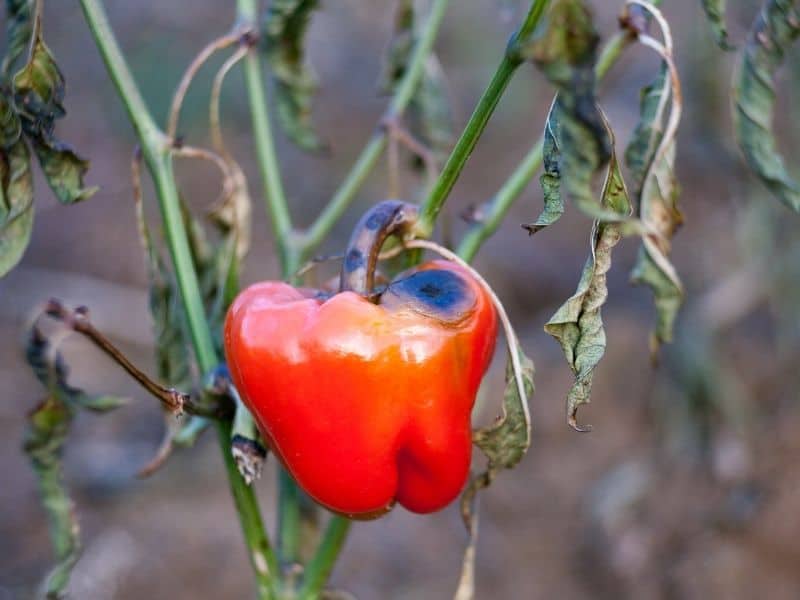
On peppers, blossom-end rot lesions typically start out tan and are often confused with sunscald (which is white). However, as with tomatoes and other fruits, the affected area may become dark brown or black.
Blossom-end rot in watermelon
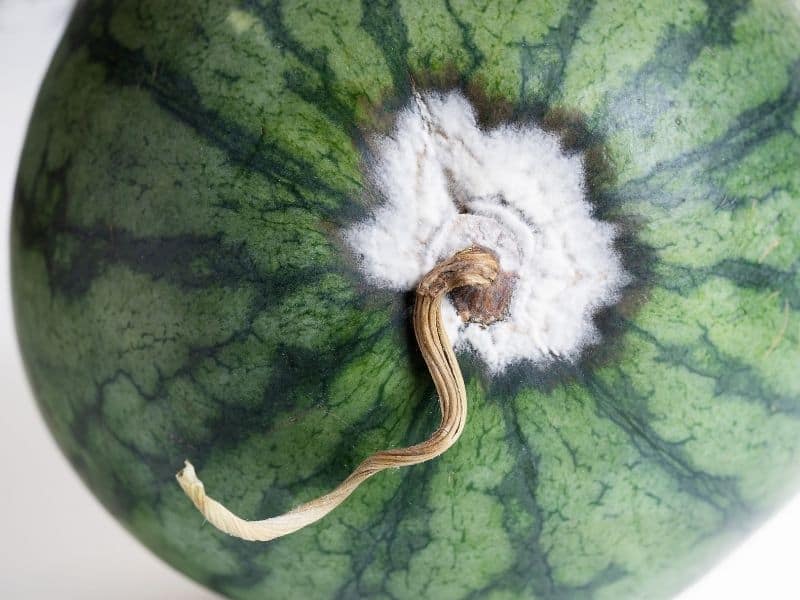
Be especially careful when watering melons: to reduce the likelihood of blossom-end rot, keep the soil moist but not wet, and never allow puddles to form around the vines.
Tomato Varieties That Are Not Susceptible To Blossom-End Rot
If you have struggled with blossom-end rot in the past, look for cultivars that are resistant to the disorder. You can choose from both heirloom and hybrid options, depending on your preference. Here are a few suggestions for tomato varieties that are not susceptible to blossom-end rot.
Druzba
(heirloom, 85 days)
Also called Drushba or Druzhba, this Bulgarian heirloom produces large yields of mini beefsteak tomatoes with excellent flavor. The four to eight-ounce fruits have smooth, deep red skins and are perfect for slicing.
Magnus
(heirloom, 79 days)
These six- to eight-ounce dark pink slicing tomatoes are wonderfully sweet, juicy, and flavorful. Also known as Livingston’s Magnus Tomato, they are resistant to cracking as well as blossom-end rot.
Manalucie
(heirloom, 82 days)
A good choice for gardens in the southern United States, these heat-tolerant slicing tomatoes do well in hot, humid regions and have leafy foliage that protects the fruits from sunscald. They produce good yields and are very juicy and flavorful.
Mountain Fresh Plus
(hybrid, 79 days)
These eight- to twelve-ounce slicers do well in cool or wet climates and are resistant to cracking and sunscald in addition to blossom-end rot. Firm, smooth, and flavorful, they are popular in commercial production, especially in the eastern and midwestern United States.
Old Brooks
(heirloom, 78 days)
A good multipurpose variety, Old Brooks produces large yields of six- to twelve-ounce bright red slicers. They are sweet, juicy, and excellent for sandwiches and salads as well as sauce and canning.
Ravello
(hybrid, 65 days)
This early maturing variety produces deep red, oblong cherry tomatoes in clusters of twelve to fifteen. Reminiscent of miniature San Marzanos, they are flavorful, crack-resistant, and perfect for salads and sauce.
Ropreco
(heirloom, 65 days)
Thick-walled, meaty, and flavorful, this Italian heirloom paste tomato is perfect for sauce, puree, and paste. The early maturing plant produces large yields, further adding to its suitability for canning.
FAQs about blossom end rot
Can you eat tomatoes with blossom-end rot?
Yes! Tomatoes, and other vegetables, affected by blossom-end rot are not always destined for the compost pile. Just cut out the lesion and use the rest of the tomato as you normally would. Of course, if the tomato is moldy, smells bad, or otherwise seems suspicious, toss it.
And always use blemished fruits promptly to prevent the edible portion from going bad too. They’re fine for eating fresh or cooking, but don’t use them in canning, as they may introduce bacteria to your sealed jars.
Can blossom-end rot be reversed?
Unfortunately, fruits that already have blossom-end rot cannot be cured. Steps can be taken, however, to improve calcium uptake in the affected plant and thus prevent additional fruits from developing lesions. See the “How to prevent blossom-end rot” section above for more details.
Does Epsom salt stop blossom-end rot?
No – in fact, it can actually worsen blossom-end rot! Epsom salt contains magnesium sulfate, which may compete with calcium for uptake into the plant. And as noted above, blossom end rot is caused by calcium deficiency.
Does blossom-end rot spread?
Because blossom-end rot is a physiological disorder, not a disease, it is not contagious and will not spread to unaffected plants.
Can overwatering cause blossom-end rot?
Yes. Too much water, too little water, and alternating between the two can all cause blossom-end rot. The problem is inconsistent moisture levels, which can inhibit the plant’s absorption and distribution of calcium.
Prevention Is the Cure
Regardless of whether plants in your garden have experienced blossom-end rot in the past, it is important to implement the prevention strategies outlined above to ensure healthy crops in the future. Compost, mulch, and consistent watering can help prevent blossom-end rot as well as a host of other tomato problems.
And if your tomatoes or other produce do show signs of blossom-end rot, don’t despair! Pick off the affected fruits and amend the soil or adjust your watering routine as necessary. Your plants will thank you.
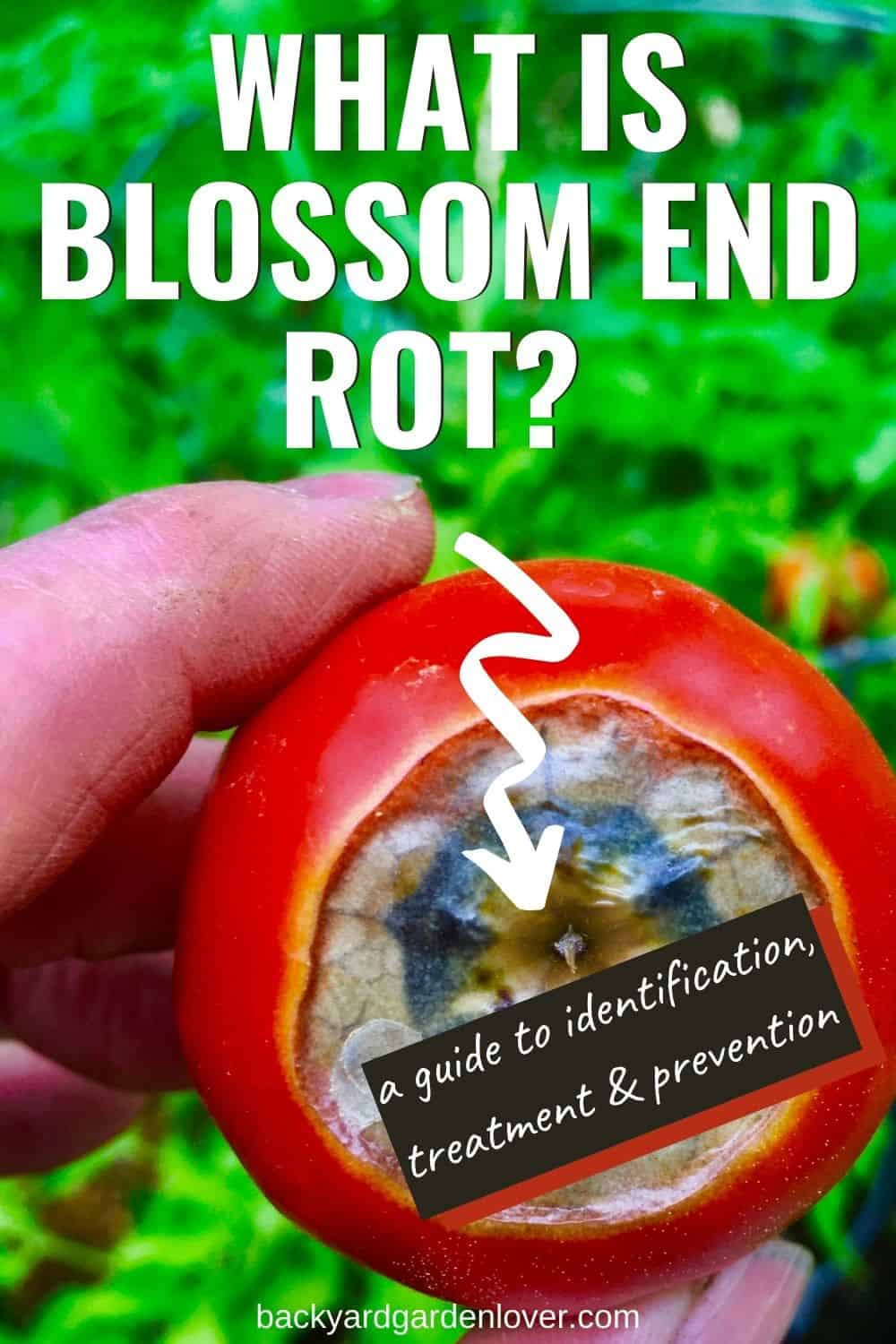






Backyard Vegetable Garden Ideas
Wednesday 17th of August 2022
[…] What Is Blossom End Rot? A Quick Guide to Identification, Treatment, and Prevention […]
How To Grow Tomatoes In Containers - 5 Tips For Success
Tuesday 17th of November 2020
[…] For the most part, your tomato plants will be happy with two simple things: ample sunlight and sufficient water. For the first, place the pots in a location that receives at least six to eight hours of sunlight per day. Watering takes a bit more effort, but it will quickly become routine. A consistent watering schedule will help prevent problems like cracking or blossom end rot. […]